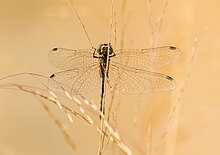Sympetrum
| Sympetrum | ||
|---|---|---|
 | ||
 Sympetrum obtrusum, Shirleys Bay, Ottawa | ||
| Taxonomía | ||
| Reino: | Animalia | |
| Filo: | Arthropoda | |
| Clase: | Insecta | |
| Orden: | Odonata | |
| Familia: | Libellulidae | |
| Género: |
Sympetrum Newman, 1833 | |
Sympetrum es un género de libélulas de tamaño pequeño a mediano. Hay más de 50 especies que viven principalmente en zonas templadas del hemisferio norte. No hay ninguna especie en Australia.
El género Sympetrum se compone de 60 especies, 22 de las cuales se distribuyen en el nuevo mundo, este grupo se distribuye principalmente en las zonas templadas del norte (Holártico) y la mayoría vuelan durante el verano tardío y el otoño. Varias especies son migratorias (Sympetrum corruptum).


- Sympetrum ambiguum (Rambur, 1842)[2]
- Sympetrum anomalum Needham, 1930
- Sympetrum arenicolor Jödicke, 1994
- Sympetrum baccha (Selys, 1884)
- Sympetrum chaconi De Marmels, 1994
- Sympetrum commixtum (Selys, 1884)
- Sympetrum cordulegaster (Selys, 1883)
- Sympetrum corruptum (Hagen, 1861)[2]
- Sympetrum costiferum (Hagen, 1861)[2]
- Sympetrum croceolum (Selys, 1883)
- Sympetrum daliensis Zhu, 1999
- Sympetrum danae (Sulzer, 1776)[3][2]
- Sympetrum darwinianum Selys, 1883[4]
- Sympetrum dilatatum (Calvert, 1892)[5]
- Sympetrum durum Bartenev, 1916
- Sympetrum eroticum (Selys, 1883)
- Sympetrum evanescens De Marmels, 1992
- Sympetrum flaveolum (Linnaeus, 1758)[3]
- Sympetrum fonscolombii (Selys, 1840)[3] nomad[6]
- Sympetrum frequens (Selys, 1883)[7]
- Sympetrum gilvum (Selys, 1884)
- Sympetrum gracile Oguma, 1915
- Sympetrum haematoneura Fraser, 1924
- Sympetrum haritonovi Borisov, 1983[8]
- Sympetrum himalayanum Navás, 1934
- Sympetrum hypomelas (Selys, 1884)
- Sympetrum illotum (Hagen, 1861)[2]
- Sympetrum imitans (Selys, 1886)
- Sympetrum infuscatum (Selys, 1883)
- Sympetrum internum Montgomery, 1943[2]
- Sympetrum kunckeli (Selys, 1884)
- Sympetrum maculatum Oguma, 1922
- Sympetrum madidum (Hagen, 1861)[2]
- Sympetrum meridionale (Selys, 1841)[4]
- Sympetrum nigrifemur (Selys, 1884)[9]
- Sympetrum nigrocreatum Calvert, 1920[10]
- Sympetrum nomurai Asahina, 1997
- Sympetrum obtrusum (Hagen, 1861)[2]
- Sympetrum orientale (Selys, 1883)
- Sympetrum pallipes (Hagen, 1874)[2]
- Sympetrum paramo De Marmels, 2001
- Sympetrum parvulum (Bartenev, 1912)
- Sympetrum pedemontanum (Müller, 1766)[3]
- Sympetrum risi Bartenev, 1914
- Sympetrum roraimae De Marmels, 1988
- Sympetrum rubicundulum (Say, 1840)[2]
- Sympetrum ruptum Needham, 1930
- Sympetrum sanguineum (Müller, 1764)[3]
- Sympetrum semicinctum (Say, 1840)[2]
- Sympetrum signiferum Cannings & Garrison, 1991
- Sympetrum sinaiticum Dumont, 1977[4]
- Sympetrum speciosum Oguma, 1915
- Sympetrum striolatum (Charpentier, 1840)[3]
- Sympetrum tibiale (Ris, 1897)
- Sympetrum uniforme (Selys, 1883)
- Sympetrum verum Bartenev, 1916
- Sympetrum vicinum (Hagen, 1861)[11][2]
- Sympetrum villosum Ris, 1911
- Sympetrum vulgatum (Linnaeus, 1758)[3][4]
- Sympetrum xiaoi Han & Zhu, 1997
Referencias
[editar]- ↑ World Odonata List
- ↑ a b c d e f g h i j k l «North American Odonata». University of Puget Sound. 2009. Consultado el 5 de agosto de 2010.
- ↑ a b c d e f g «Checklist of UK Species». British Dragonfly Society. Consultado el 5 de agosto de 2010.
- ↑ a b c d «Checklist, English common names». DragonflyPix.com. Archivado desde el original el 4 de diciembre de 2012. Consultado el 5 de agosto de 2010.
- ↑ Suhling, F.; Martens, A. (2011). «Sympetrum dilatatum». The IUCN Red List of Threatened Species (IUCN) 2011: e.T21226A9259879. doi:10.2305/IUCN.UK.2011-1.RLTS.T21226A9259879.en. Consultado el 23 de diciembre de 2017.
- ↑ Samways, Michael J. (2008). Dragonflies and damselflies of South Africa (1st edición). Sofia: Pensoft. ISBN 9546423300.
- ↑ Autumn Darter, Kochi
- ↑ Clausnitzer, V. (2009). «Sympetrum haritonovi». The IUCN Red List of Threatened Species (IUCN) 2009: e.T158697A5261939. doi:10.2305/IUCN.UK.2009-2.RLTS.T158697A5261939.en. Consultado el 23 de diciembre de 2017.
- ↑ Kalkman, V.J. (2009). «Sympetrum nigrifemur». Lista Roja de especies amenazadas de la UICN 2024 (en inglés). ISSN 2307-8235. Consultado el 25 Aug 2010.
- ↑ Paulson, D. R. (2009). «Sympetrum nigrocreatum». The IUCN Red List of Threatened Species (IUCN) 2009: e.T164924A5939416. doi:10.2305/IUCN.UK.2009-2.RLTS.T164924A5939416.en. Consultado el 23 de diciembre de 2017.
- ↑ Dunkle, S. W. (2000). Dragonflies through Binoculars. OUP.
Text is available under the CC BY-SA 4.0 license; additional terms may apply.
Images, videos and audio are available under their respective licenses.
